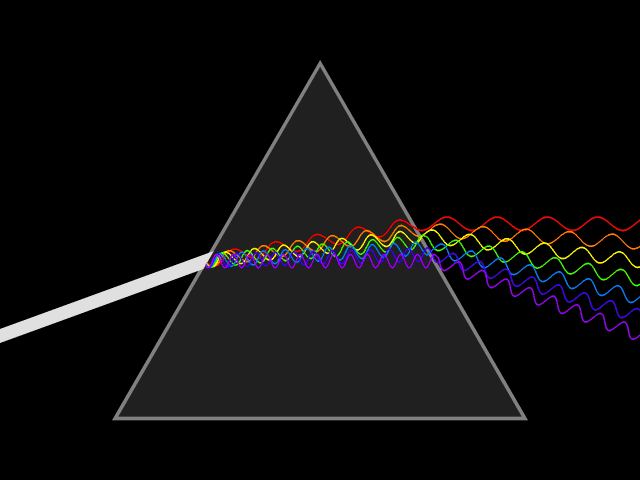|
Ionospheric Pierce Point
Most global navigation satellite systems (GNSS) are subjected to errors induced by the ionosphere. Because ionospheric delay affects the speed of microwave signals differently depending on their frequency—a characteristic known as dispersion, delays measured on two or more frequency bands can be used to measure dispersion, and this measurement can then be used to estimate the delay at each frequency. The principal source of the dispersion comes from the total electron content (TEC) in the ionosphere, along the line of sight from the satellite to the receiver. Because it is difficult to measure the TEC along the line of sight, instead a prediction can be made using a simplified model of the ionosphere. This model assumes that the ionosphere is a thin, uniform-density shell about the earth, located near the mean altitude ''H'' of maximum TEC (approx. 350 km). Using geometry, a slant intersection with this shell model can be determined and a vertical TEC measurement inferred ... [...More Info...] [...Related Items...] OR: [Wikipedia] [Google] [Baidu] |
Global Navigation Satellite System
A satellite navigation or satnav system is a system that uses satellites to provide autonomous geo-spatial positioning. It allows satellite navigation devices to determine their location (longitude, latitude, and altitude/elevation) to high precision (within a few centimetres to metres) using time signals transmitted along a line of sight by radio from satellites. The system can be used for providing position, navigation or for tracking the position of something fitted with a receiver (satellite tracking). The signals also allow the electronic receiver to calculate the current local time to a high precision, which allows time synchronisation. These uses are collectively known as Positioning, Navigation and Timing (PNT). One set of critical vulnerabilities in satellite communications are the signals that govern positioning, navigation and timing (PNT). Failure to properly secure these transmissions could not only disrupt satellite networks but wreak havoc on a host of dependent s ... [...More Info...] [...Related Items...] OR: [Wikipedia] [Google] [Baidu] |
Ionosphere
The ionosphere () is the ionized part of the upper atmosphere of Earth, from about to above sea level, a region that includes the thermosphere and parts of the mesosphere and exosphere. The ionosphere is ionized by solar radiation. It plays an important role in atmospheric electricity and forms the inner edge of the magnetosphere. It has practical importance because, among other functions, it influences radio propagation to distant places on Earth. History of discovery As early as 1839, the German mathematician and physicist Carl Friedrich Gauss postulated that an electrically conducting region of the atmosphere could account for observed variations of Earth's magnetic field. Sixty years later, Guglielmo Marconi received the first trans-Atlantic radio signal on December 12, 1901, in St. John's, Newfoundland (now in Canada) using a kite-supported antenna for reception. The transmitting station in Poldhu, Cornwall, used a spark-gap transmitter to produce a signal with a f ... [...More Info...] [...Related Items...] OR: [Wikipedia] [Google] [Baidu] |
Ionospheric Delay
The error analysis for the Global Positioning System is important for understanding how GPS works, and for knowing what magnitude of error should be expected. The GPS makes corrections for receiver clock errors and other effects but there are still residual errors which are not corrected. GPS receiver position is computed based on data received from the satellites. Errors depend on geometric dilution of precision and the sources listed in the table below. Overview User equivalent range errors (UERE) are shown in the table. There is also a numerical error with an estimated value, \ \sigma_ , of about . The standard deviations, \ \sigma_R, for the coarse/acquisition (C/A) and precise codes are also shown in the table. These standard deviations are computed by taking the square root of the sum of the squares of the individual components (i.e., RSS for root sum squares). To get the standard deviation of receiver position estimate, these range errors must be multiplied by the ap ... [...More Info...] [...Related Items...] OR: [Wikipedia] [Google] [Baidu] |
Dispersion (optics)
In optics, and by analogy other branches of physics dealing with wave propagation, dispersion is the phenomenon in which the phase velocity of a wave depends on its frequency; sometimes the term chromatic dispersion is used for specificity to optics in particular. A medium having this common property may be termed a dispersive medium (plural ''dispersive media''). Although the term is used in the field of optics to describe light and other electromagnetic waves, dispersion in the same sense can apply to any sort of wave motion such as acoustic dispersion in the case of sound and seismic waves, and in gravity waves (ocean waves). Within optics, dispersion is a property of telecommunication signals along transmission lines (such as microwaves in coaxial cable) or the pulses of light in optical fiber. Physically, dispersion translates in a loss of kinetic energy through absorption. In optics, one important and familiar consequence of dispersion is the change in the angle of refra ... [...More Info...] [...Related Items...] OR: [Wikipedia] [Google] [Baidu] |
Total Electron Content
Total electron content (TEC) is an important descriptive quantity for the ionosphere of the Earth. TEC is the total number of electrons integrated between two points, along a tube of one meter squared cross section, i.e., the electron columnar number density. It is often reported in multiples of the so-called ''TEC unit'', defined as TECU1016el/m2. TEC is significant in determining the scintillation and group and phase delays of a radio wave through a medium. Ionospheric TEC is characterized by observing carrier phase delays of received radio signals transmitted from satellites located above the ionosphere, often using Global Positioning System satellites. TEC is strongly affected by solar activity. Formulation The TEC is path-dependent. By definition, it can be calculated by integrating along the path ''ds'' through the ionosphere with the location-dependent electron density ''ne(s)'': : TEC = \int n_e(s)\,ds The ''vertical'' TEC (''VTEC'') is determined by integration of ... [...More Info...] [...Related Items...] OR: [Wikipedia] [Google] [Baidu] |
Satellite
A satellite or artificial satellite is an object intentionally placed into orbit in outer space. Except for passive satellites, most satellites have an electricity generation system for equipment on board, such as solar panels or radioisotope thermoelectric generators (RTGs). Most satellites also have a method of communication to ground stations, called transponders. Many satellites use a standardized bus to save cost and work, the most popular of which is small CubeSats. Similar satellites can work together as a group, forming constellations. Because of the high launch cost to space, satellites are designed to be as lightweight and robust as possible. Most communication satellites are radio relay stations in orbit and carry dozens of transponders, each with a bandwidth of tens of megahertz. Satellites are placed from the surface to orbit by launch vehicles, high enough to avoid orbital decay by the atmosphere. Satellites can then change or maintain the orbit by pr ... [...More Info...] [...Related Items...] OR: [Wikipedia] [Google] [Baidu] |
Anny Cazenave
Anny Cazenave () is a French space geodesist and one of the pioneers in satellite altimetry. She works for the French space agency CNES and has been deputy director of the (LEGOS) at Observatoire Midi-Pyrénées in Toulouse since 1996. Since 2013, she is director of Earth sciences at the International Space Science Institute (ISSI), in Bern (Switzerland). As one of the leading scientists in the joint French/American satellite altimetry missions TOPEX/Poseidon, Jason-1, and the Ocean Surface Topography Mission, she has contributed to a greater understanding of sea level rise caused by global warming. Cazenave is a member of the Intergovernmental Panel on Climate Change and was the lead author of the sea level sections for their fourth and fifth Assessment Reports. Early life and education Not from an academic background, Cazenave was not destined to work in the sciences. However, she achieved a postgraduate doctorate in fundamental astronomy (Paris, 1969) as well as rece ... [...More Info...] [...Related Items...] OR: [Wikipedia] [Google] [Baidu] |
Global Positioning System
The Global Positioning System (GPS), originally Navstar GPS, is a satellite-based radionavigation system owned by the United States government and operated by the United States Space Force. It is one of the global navigation satellite systems (GNSS) that provides geolocation and time information to a GPS receiver anywhere on or near the Earth where there is an unobstructed line of sight to four or more GPS satellites. It does not require the user to transmit any data, and operates independently of any telephonic or Internet reception, though these technologies can enhance the usefulness of the GPS positioning information. It provides critical positioning capabilities to military, civil, and commercial users around the world. Although the United States government created, controls and maintains the GPS system, it is freely accessible to anyone with a GPS receiver. The GPS project was started by the U.S. Department of Defense in 1973. The first prototype spacecraft wa ... [...More Info...] [...Related Items...] OR: [Wikipedia] [Google] [Baidu] |





